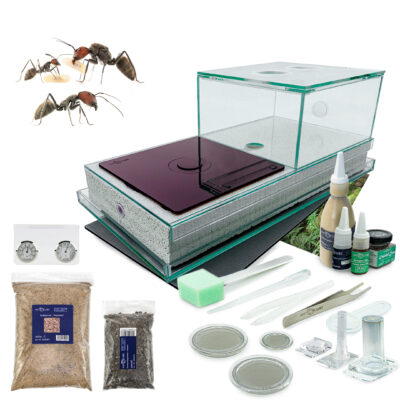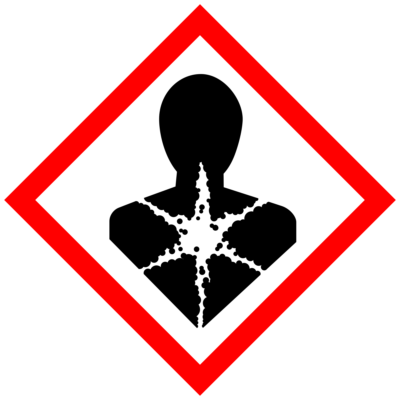Bundle Offer – Camponotus singularis
319,90 €
incl. VAT plus Shipping Costs
Connection: 1x14mm 1x27mm
Size: M – L
Only 2 left in stock
Bundle offer including a Camponotus singularis ant colony (queen with 11-25 workers + brood)
Only while stocks last.
Shipping only possible via GO! inside of Germany.
1x Camponotus singularis queen + 11-25 workers + brood
1x Ytong nest – 40×20 with arena
1x glass tub 40×20
1x formicarium pad – 40x20cm
1x red cover plate 20×20 – horizontal
1x Clay color – beige – 100ml
1x substrate – rainforest – 1kg
1x Formicarium granules 200 ml – black
1x photo back panel – rainforest – 20×10
2x grid insert – 50mm – stainless steel
1x grid insert – 27mm – stainless steel
1x Cricket Jam 25g
1x Honeydew Mix (HT) – refill pack 10ml
1x Drinking trough 2ml – 360 degrees
1x Drinker clear 20ml – sponge
1x bowl clear 1×20 – sponge
1x Mini thermo-hygrometer analog – display – hanging
1x Ant protection oil 10ml
1x Tweezers spring steel – wide – soft
1x Tweezers plastic transparent
1x plastic pipette 3ml
1x hand magnifier – 2x – 30mm
1x foam wiper 150x18x2,5mm
Ant species Camponotus singularis:
Camponotus singularis is a very beautiful and very large ant species from Southeast Asia. They are mainly nocturnal, but are also active during the day due to the usually lower light intensity in the home. They also form particularly large majors quite early on, which defend the colony. They can often be seen sitting at the entrance to the nest.
Their colonies can grow to several thousand animals in the wild. But don’t worry, this takes a few years.
You can feed them with sugar-honey solution, honey and protein food or even small live insects such as crickets and fruit flies. The active hunting behavior is only really developed in larger colonies. As is usual with Camponotus species, the development from egg to worker takes a few weeks.
Humidity and temperature in the arena must be increased slightly at most, but the nest should always be moist. The animals prefer differently humid areas in the nest.
Camponotus singularis is relatively lazy when it comes to digging nests. We therefore decided to use a Ytong nest. The prefabricated chambers and passages can be used directly by the colony. The Ytong nest can be easily moistened using the glass tub included. Simply pour a little water into the tub and wait until the Ytong stone absorbs the water on its own.
Information about the Ytong nest with arena:
Contains:
Material: aerated concrete, glass, PMMA plastic and PVC
Connection: 1x 14mm opening; 1x 27mm opening
Contents:
1x aerated concrete block 40x20x5 cm with 20mm deep chambers
1x glass plate 40×20 cm with a 50mm opening and a 20×20 cm arena
1x ant arena frame 20×20
1x ant arena cover 20×20
1x 50mm ring with 27mm opening
1x formicarium plug 13mm
2x formicarium plugs 27mm
2x 50mm formicarium plugs
Due to its water-retaining properties, the material is well suited for keeping ants. It can be used to keep a large number of earth-nesting species from both dry and moist habitats. Depending on the ant species, it is advisable to cover the bottom of the chambers with clay paint and soil substrate. Some species feel more comfortable this way and Ponerinae species, for example, need soil so that their larvae can pupate properly. As this nest already contains an arena, it can be used as a complete formicarium system.
Note:
To prevent water from leaking out of the Ytong after moistening the nest area and accumulating on the surface of the furniture underneath, or the rough material scratching the surfaces, we recommend one of our matching glass trays for our Ytong nests. These are waterproof and effectively protect the surfaces underneath against water and scratch damage.
Use:
For ant species of size M – L
Aerated concrete is a very brittle and fragile material. It is therefore impossible to prevent corners and edges from breaking off and becoming slightly uneven during production. For this reason, Ytong nests are not suitable for very small ant species of size S, as these species could easily break out.
Important: Please moisten the substrate before use so that the mixture can bond and develop a firm hold in the ant farm. If the substrate is too dry and dusty, it can also block the ants’ respiratory tracts and, in the worst case, cause them to suffocate.
Notes on production
The glass is cut to size in accordance with DIN 1249 with a tolerance of +/- 1 mm. Additional break-out protection is essential for extremely small ant species.
Note Clay paint:
Description: This mixture is non-toxic and relatively water-resistant on plaster and concrete, but is otherwise water-soluble.
Instructions for use:
This mixture is ready to use and can be applied immediately to plaster or aerated concrete with a brush.
100ml is sufficient for approx. 1/4m² of aerated concrete or 1/2m² of plaster.
When wet, the surface can be sprinkled with sand, for example, to achieve an even more natural look.
| Weight | 6,9300 kg |
|---|---|
| Dimensions | 45,00 × 25,00 × 15,00 cm |
Product safety
Manufacturer information
ANTSTORE, Martin Sebesta
Selerweg 41
D-12169 Berlin
Phone: +49 30 439 70 38 70
Email: law@ants.de
VAT ID No.: DE215167549
WEEE-Reg.-No. DE 54590387
Person responsible for the EU
ANTSTORE, Martin Sebesta
Selerweg 41
D-12169 Berlin
Phone: +49 30 439 70 38 70
Email: law@ants.de
VAT ID No.: DE215167549
WEEE-Reg.-No. DE 54590387
GPSR
Declaration of Conformity / GPSR Declaration EU (2023/988) for
- product: ANTCUBE Bundle Offer – Camponotus singularis
Brand: ANTCUBE
Item number: SKU1005691
Serial number:
Batch number:

- Authorized representative: Dealer or manufacturer
Name: ANTSTORE
Address: Selerweg 41; 12169 Berlin – Germany
Email: gpsr@ants.de
Website: www.antstore.de
Phone: (+49) 30 4397038-71
- This declaration is issued under the sole responsibility of the manufacturer/distributor.
GPSR / Product safety information.
Since 13.12.2024, we have been obliged to inform consumers about the safety and hazards of our products.
The manufacturer / distributor applied the conformity assessment procedure with internal production control. A notified body was not involved.
Additional information:
We hereby declare that the applicable provisions of the GPSR Regulation EU (2023/988)have been complied with in relation to the item shown to the extent indicated below.
We hereby declare that the technical documentation has been prepared in accordance with Directive 2023/988.
We undertake to provide the relevant information on the above partially completed point upon reasoned request from the competent national authorities. The transmission will be made by e-mail.
The technical documentation for the above items can be obtained from the authorized representative at the address below.
Warning: Not suitable for children under 14 years. Wear gloves. Beware of sharp edges, risk of cuts! Small parts: Risk of choking / suffocation. If necessary, wear a respirator mask and safety goggles when assembling or working. Adult supervision is recommended. Warning ! This is not a toy and offers no protection. Please keep this information for future reference. In the event of an accident, please go to a doctor or hospital immediately for medical treatment.

By complying with the GPSR, we actively contribute to product safety and consumer protection. Thank you for choosing high-quality and safe products!
We would also like to take this opportunity to point out the following:
Confirmation of compliance with the Supply Chain Due Diligence Act (LkSG):
Although this is not required by law, we would like to take this opportunity to expressly confirm that we comply with the guidelines of the German Supply Chain Duty of Care Act (LkSG).
We are committed to attaching particular importance to the following points within our supply chains:
- Human rights: Ensuring that fundamental human rights are respected and upheld along the entire supply chain.
- Environmental protection: Compliance with environmental standards to minimize negative ecological impacts.
- Due diligence obligations: Identifying, assessing and avoiding risks by continuously reviewing our supply chains.
- Cooperation with partners: Cooperation with suppliers and business partners to ensure compliance with these standards.
We consider the implementation of the LkSG guidelines to be a fundamental part of our corporate responsibility and will continue to take all necessary measures in the future to maintain the highest standards of due diligence.
For further information on our measures under the LkSG, please do not hesitate to contact us.
Our products consist of the following materials with packaging protection:
Float glass: All glass objects from ANTSTORE
Production / Distribution via: Scholl Glas / ANTSTORE
Warnings: Danger of cuts, it is recommended to wear gloves
CAS number. 65997173, EINECS No. 2660460
Technical property: Sodium calcium silicate glass 4 mm +/- 1 mm tolerance. Flammable from 1300 °C.
Care instructions: Not suitable for dishwashers: Please do not clean in the dishwasher, as the temperatures could cause the material to deform.
Risk assessment, probability of occurrence of possible damage: No risk if handled properly. Working with glass requires protective gloves. Formicaria and nests for keeping ants are intended exclusively for this purpose and must not be used for other purposes.
Cleanable with water and a soft cloth (microfiber).
Sustainability: 100% given, natural product. Dimensional stability over 20 years.
Repairability: Given. Please contact us.
 Disposal: Can be recycled. Please contact your local authority / municipal waste management company for suitable recycling.
Disposal: Can be recycled. Please contact your local authority / municipal waste management company for suitable recycling.
PC (polycarbonate), feed dispenser, water dispenser, cover plug
Production / Distribution via: ANTSTORE
Warnings: PC is not biodegradable and may contain harmful chemicals. Fire class B1 at approx. 230 °C .
CAS number: 25037-45-0
Technical properties:Are thermoplastics, formally consisting of polyester of carbonic acid. Transparent & colorless, but can be dyed as an alternative to glass. Moldable at approx. 180 degrees Celsius.
Risk assessment, probability of occurrence of possible damage: No risk if handled properly. Risk of ingestion by small children! Observe duty of supervision!
Care instructions: Only with microfiber cloth and water. Do not use alcohol or solvents.
Repairability: Can be bonded with reaction resin adhesives and is ultrasonic and high-frequency weldable. However, it is recommended in this context to have it carried out by an expert workshop.
 Disposal: Waste / Recycling: The product must not be thrown into the normal waste garbage can and should not come into contact with the sewage system. Please contact your local authority / municipal waste management department for appropriate recycling.
Disposal: Waste / Recycling: The product must not be thrown into the normal waste garbage can and should not come into contact with the sewage system. Please contact your local authority / municipal waste management department for appropriate recycling.
PP polypropylene – syringes, water bottles, tubes, pipettes, petri dishes, collection boxes
Production / Distribution via: ANTSTORE
Warnings: Polypropylene is not biodegradable and may contain harmful chemicals. Fire class B1, flammable at approx. 260°C.
CAS number: 9003-07-0
Technical property: Polypropylene (PP) is a thermoplastic produced by chain polymerization of propene.
Risk assessment, probability of occurrence of possible damage: No risk if handled properly.
Care instructions: Only with microfiber cloth and water.
Repairability: unknown
 Disposal: Waste / Recycling: The product must not be thrown into the normal waste garbage can and should not come into contact with the sewage system. Please contact your local authority / municipal waste management department for appropriate recycling.
Disposal: Waste / Recycling: The product must not be thrown into the normal waste garbage can and should not come into contact with the sewage system. Please contact your local authority / municipal waste management department for appropriate recycling.
PE – Polyethylene mailing bags e.g. for substrates, pipes, bottles, cable insulation, bubble wrap, cling film, carpet pad.
Production / Distribution via: ANTSTORE
Warnings: Polyethylene is not biodegradable and may contain harmful chemicals. It burns without residue with a dripping, bright flame, even after the flame causing the fire has been removed. The exhaust gas smells similar to that of a wax candle flame. Fire class: The self-ignition temperature is 360°C.
Risk assessment, probability of occurrence of possible damage: No risk if handled properly.
CAS number: 9002-88-4
Technical property: is a thermoplastic produced by chain polymerization of mostly petrochemicals. Polyethylene is of low strength, hardness and rigidity, but has high ductility and impact strength. Polyethylene feels waxy to the touch and expands greatly when heated.
Care instructions: With microfiber cloth and water. Do not use alcohol or solvents.
Repairability: unknown


Disposal: Waste / Recycling: The product must not be thrown into the normal waste garbage can and should not come into contact with the sewage system. Please contact your local authority / municipal waste management department for appropriate recycling.
Ytong: Nest
Production / Distribution via: ANTSTORE
Warnings: No apparent hazards if handled properly.
Technical property: Solid, flame-retardant natural mineral.
Care instructions: Only to be cleaned dry, preferably with a brush or paintbrush
Risk assessment, probability of occurrence of possible damage: No risk if handled properly. Working with plaster in glass requires protective gloves. Formicaria and nests for keeping ants are intended exclusively for this purpose and must not be used for other purposes. See also safety data sheet.
Sustainability: Consists of quartz sand, lime, cement and water, as well as a small amount of aluminum as a blowing agent for the pore structure. Given. Can be returned to the circular economy to remanufacture building materials.
Repairability: Given. With lime / cement.
Disposal: Can be recycled. Please contact your local authority / municipal waste management company for suitable recycling.
PS (polystyrene) – Expanded polystyrene (EPS) – Styrofoam – Shipping protection corners or thermal insulation box
Production / distribution via: Storopack / ANTSTORE
Warnings: EPS is not biodegradable and may contain harmful chemicals. Fire class B1, flammable at approx. 230 °C.
CAS number: 9003-53-6
Risk assessment, probability of occurrence of possible damage: No risk if handled properly.
Technical properties: Solid, thermoplastic material with the highest insulation value and low weight.
Care instructions: Primarily for packaging protection purposes.
Repairability: adhesive tape.
Disposal: Waste / Recycling: The product must not be thrown into the normal waste garbage can and should not come into contact with the sewage system. Please contact your local authority / municipal waste management department for appropriate recycling.


Silicone – Synthetic polymers (dried)
Production / Distribution via: ANTSTORE
Warning notices: Observe eye, nose and hand protection when working. Processing temperature from 5 °C to 40 °C.
Flammable: At approx. 150 °C .
CAS number: 63394-02-5
Risk assessment, probability of occurrence of possible damage: No risk if handled properly.
Technical property: Silicone fluids are clear, colorless, neutral, odorless, hydrophobic liquids. Lubricating.
Care instructions: Silicone fluids are soluble in benzene, toluene, aliphatics and chlorinated hydrocarbons. They are not very resistant to strong inorganic acids and bases.
 Disposal: Waste / Recycling: The product must not be thrown into the normal waste garbage can and should not come into contact with the sewage system. Please contact your local authority / municipal waste management department for appropriate recycling.
Disposal: Waste / Recycling: The product must not be thrown into the normal waste garbage can and should not come into contact with the sewage system. Please contact your local authority / municipal waste management department for appropriate recycling.
Paper / Cardboard – Packaging
Production / Distribution via: ANTSTORE
Warning notices: Both paper and cardboard boxes can have sharp edges. Gloves offer sufficient protection when handling the material. Highly flammable.
Risk assessment, probability of occurrence of possible damage: No risk if handled properly.
Technical property: Solid 
 Disposal: Waste / Recycling: Can be reused. It is also naturally degradable or compostable. Please contact your local authority / municipal waste management for suitable recycling.
Disposal: Waste / Recycling: Can be reused. It is also naturally degradable or compostable. Please contact your local authority / municipal waste management for suitable recycling.
Paraffin oil: Breakout protection oil
Production / Distribution via: ANTSTORE
Warnings: May be fatal if swallowed and enters airways. May cause eye and skin irritation. In such cases, seek urgent medical advice.
CAS No.: 8042-47-5

Risk assessment, probability of occurrence of possible damage: No risk if handled properly.
Technical property: Liquid polymers.
Care instructions: Can be wiped clean with a microfiber cloth.
 Disposal: Waste / Recycling: The product must not be thrown into the normal waste garbage can and should not come into contact with the sewage system. Please contact your local authority / municipal waste management department for appropriate recycling.
Disposal: Waste / Recycling: The product must not be thrown into the normal waste garbage can and should not come into contact with the sewage system. Please contact your local authority / municipal waste management department for appropriate recycling.
Stainless steel / mesh insert , spring steel tweezers
Production / Distribution via: ANTSTORE
Warnings: Risk of cuts and punctures, risk of swallowing small parts if handled incorrectly.
CAS number: 65997-19-5
Care instructions: Can be cleaned with a microfiber cloth.
 Disposal: Waste / Recycling: The product can be reused. It is therefore recyclable. Please contact your local authority / municipal waste management company for suitable recycling.
Disposal: Waste / Recycling: The product can be reused. It is therefore recyclable. Please contact your local authority / municipal waste management company for suitable recycling.
Responsibly signed for and on behalf of: ANTSTORE
Contact: www.antstore.net / www.antcube.shop
Place of issue: Selerweg 41; 12169 Berlin
Berlin / Germany
Date of issue: December 12, 2024
Name: Martin Sebesta
Position: Business owner / managing director
Signature:
Only logged in customers who have purchased this product may leave a review.
Related Products
Bundle offers - Starter sets with ants
incl. VAT
plus Shipping Costs
Delivery time: Germany 1-3 workdays
Bundle offers - Starter sets with ants
incl. VAT
plus Shipping Costs
Delivery time: Germany 1-3 workdays





























Reviews
There are no reviews yet.